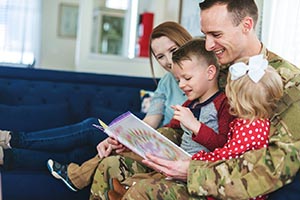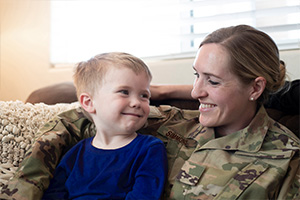Preparing for a permanent change of station? Moving as a military family comes with certain restrictions that other relocations don’t; check these items off your list to make your move easier.
Your spouse just got their orders: it’s time to move to a new duty station. If this is your first PCS (Permanent Change of Station) as a military spouse, it’s a good idea to review some of the differences in this PCS moving process that you wouldn’t normally deal with moving as a civilian. From weight restrictions on household goods to military moving assistance, these are steps you can take to feel more confident about your upcoming journey.
Do research about your military PCS move
Try to learn what you can about your new home base; any familiarizing you can do will make the transition easier for you and your family. The Military Family Readiness System makes family assistance available through your military base, so start your research by reaching out to your family center about your PCS move. Here are some other ways to get to know your new home:
- Military-based PCS resources: The military provides resources to help you with your move. Military OneSource is a great place to find information about PCS moves, military family life and more; here you’ll find planning tools and learn about relocation assistance.
- Google search: Take to the internet to review walkability scores and proximity to area schools and resources like food and gas. You can also use Google Maps to get an idea of your new neighborhood with the street view function.
- Social media: Connecting with people via social media is good for gauging your new community. Join Facebook groups for military spouses in the area and see if your new command station has any social media channels you can follow to stay on top of local news.
Start saving ahead of your military PCS move
Moving is always more expensive than expected, and while the military will provide your family with funding for relocating, there are other costs to consider when setting a savings goal.
- Packing and moving day: While tipping military-hired movers is discouraged, some military families buy lunch and waters for their moving crew to keep spirits up during the lengthy process.
- Gaps in employment: If you are currently working, consider what your situation will be when you’re at your new base. Will you be transferring to a new job immediately? Will you be unemployed? Budget to account for any expected (or unexpected) gaps between jobs.
- Emergencies: No one wants to think about accidents happening, but it’s better to be safe than sorry. Set money aside to pay for things like emergency care or mechanical breakdowns.
Choose a PCS moving method: Military move vs PPM
With a PCS, you have the option to have the military coordinate the packing, moving and storage of your household goods. Local movers will be assigned to you and will not only transport your goods, but they’ll pack them as well. This packing and moving can take 1-2 full days, so it’s recommended you do as much prep work as you can as far as grouping like items together and removing art from walls.
Your other option is to move yourselves, which is known as a Personally Procured Move (PPM), formerly DITY, or Do-It-Yourself move; hybrid options are sometimes available as well. The military gives an allowance if you move yourself and take over responsibility of making moving arrangements. Choose a method of moving that fits your capacity of time and energy.
Make a military PCS family folder to carry with you
Just to be safe, all your family’s important documents should stay with you during the move, and not be relocated by movers. During the PCS moving process, you’ll be handing out multiple copies of your PCS orders, so be sure to make duplicates. Here are some of the important PCS documents you should keep in your folder:
- PCS orders (multiple copies)
- Original birth certificates (all travelers)
- Marriage licenses
- Social security cards (all travelers)
- Driver’s license, permit or state ID (or passport, if applicable)
- Medical, dental and immunization records (all travelers)
- Deeds and titles to all property
- Legal documents like wills and powers of attorney
- State and federal income tax returns
- Documentation on household goods
Lighten your load before your PCS move
With a military move, your household goods are limited by a weight of up to 18,000 pounds, sometimes less depending on rank or situation. To skinny down and meet weight requirements, use this opportunity to reevaluate your personal possessions and trim down if you can. Cleaning and purging unwanted goods will set the stage for a faster, easier packing and moving day. You could even make some extra cash by holding a yard sale; donate whatever doesn’t sell and discard the rest. This is also a good time to review what you can and cannot bring in a PCS move so you’re not having to schedule last-minute deliveries or throw things away on moving day.
Take safeguarding measures
Take photos of all your valuables and make a note of their estimated worth in case you need to file for any damages that might happen in transit. If anyone in your household takes prescription medicine, connect with your family doctor about getting an extra refill to tide you over during the transition. If moving into a rental or military housing, take photos of the new house before moving everything in just in case there are any damages brought up when it comes time to move out.
The most important thing to keep in mind as a military spouse during a PCS move is to remain flexible and stay strong. If you do your research on the military PCS moving process and prep your family, pets and household goods as much as you can, you can feel good about your upcoming journey.
Learn more about how U.S. Bank supports the military and their families.














